INSULIN HUMAN ISOPHANE SUSPENSION - INJECTION
PHONETIC PRONUNCIATION: (IN-sue-lin HYOO-muhn EYE-sew-fane)
COMMON BRAND NAME(S): Humulin N, Novolin N
GENERIC NAME(S): insulin NPH human isophane
Uses
USES: Insulin isophane is used with a proper diet and exercise program to control high blood sugar in people with diabetes. Controlling high blood sugar helps prevent kidney damage, blindness, nerve problems, loss of limbs, and sexual function problems. Proper control of diabetes may also lessen your risk of a heart attack or stroke. This man-made insulin product is the same as human insulin. It replaces the insulin that your body would normally make. It is an intermediate-acting insulin (isophane). It starts to work more slowly but lasts longer than regular insulin. Insulin isophane works by helping blood sugar (glucose) get into cells so your body can use it for energy. Insulin isophane is often used in combination with a shorter-acting insulin. It may also be used alone or with other oral diabetes drugs (such as metformin).
How to use INSULIN HUMAN ISOPHANE SUSPENSION - INJECTION
HOW TO USE: Read the Patient Information Leaflet provided by your pharmacist before you start using insulin isophane and each time you get a refill. If you have any questions, ask your doctor, diabetes educator, or pharmacist. Learn all preparation and usage instructions from your health care professional and the product package. Before using, gently roll the vial or cartridge, turning it upside down and right side up 10 times to mix the medication. Do not shake the container. Check this product visually for particles or discoloration. If either is present, do not use the insulin. Insulin isophane should look evenly cloudy/milky after mixing. Do not use if you see clumps of white material, a "frosty" appearance, or particles stuck to the sides of the vial or cartridge. Before injecting each dose, clean the injection site with rubbing alcohol. Change the injection site each time to lessen injury under the skin and to avoid developing problems under the skin (lipodystrophy). Inject this medication under the skin as directed by your doctor, usually once or twice a day. This insulin product may be injected in the stomach area, the thigh, the buttocks, or the back of the upper arm. Do not inject into a vein or muscle because very low blood sugar (hypoglycemia) may occur. Do not rub the area after the injection. Do not inject into skin that is red, swollen, or itchy. Do not inject cold insulin because this can be painful. The insulin container you are currently using can be kept at room temperature. This product may be mixed only with certain other insulin products such as insulin regular. Always draw the insulin regular into the syringe first, then follow with the longer-acting insulin. Never inject a mixture of different insulins into a vein. Consult your health care professional about which products may be mixed, the proper method for mixing insulin, and the proper way to inject mixtures of insulin. Do not mix insulins if you are using an insulin pump. Do not change brands or types of insulin without directions on how to do so from your doctor. Do not share your pen device with another person, even if the needle is changed. You may give other people a serious infection, or get a serious infection from them. Learn how to store and discard medical supplies safely. The dosage is based on your medical condition and response to treatment. Measure each dose very carefully because even small changes in the amount of insulin may have a large effect on your blood sugar. Check your blood sugar regularly as directed by your doctor. Keep track of your results and share them with your doctor. This is very important in order to determine the correct insulin dose. Use this medication regularly to get the most benefit from it. To help you remember, use it at the same time each day. Tell your doctor if your condition does not improve or if it worsens (your blood sugar is too high or too low).
Side Effects
Precautions
Interactions
Overdose
Images
Reviews
Faq for INSULIN HUMAN ISOPHANE SUSPENSION - INJECTION
Insulin Human Isophane Suspension - Injection is a medication used to control blood sugar levels in people with diabetes.
It works by replacing the insulin that the body would normally produce. It helps regulate blood sugar levels by allowing sugar to enter cells for energy.
The dosage and administration of this medication depend on various factors, including the individual's insulin requirements, blood sugar levels, and doctor's recommendation. It is typically injected under the skin, and the dosage is determined by a healthcare professional.
This medication starts working about 30 minutes after injection, and its peak effect occurs within 2 to 8 hours. The duration of its action can last up to 24 hours.
Common side effects may include redness, swelling, or itching at the injection site. It can also cause low blood sugar levels (hypoglycemia), which may result in symptoms such as hunger, headache, dizziness, confusion, or sweating.
It is essential to monitor your blood sugar levels regularly, follow a proper diet and exercise plan, and avoid skipping meals. Inform your healthcare provider about any other medications or medical conditions you have, as they may interact with this medication.
It is important to consult with your healthcare provider if you are pregnant, planning to become pregnant, or breastfeeding. They will evaluate the risks and benefits to determine if this medication is suitable for you.
If you miss a dose, take it as soon as you remember. However, if it is close to your next scheduled dose, skip the missed dose and resume your regular dosing schedule. Do not take a double dose to make up for a missed one.
Yes, there are generic versions of this medication available, which may be more affordable than the brand name version. Consult with your pharmacist or healthcare provider for more information.
Disclaimer
IMPORTANT: HOW TO USE THIS INFORMATION: This is a summary and does NOT have all possible information about this product. This information does not assure that this product is safe, effective, or appropriate for you. This information is not individual medical advice and does not substitute for the advice of your health care professional. Always ask your health care professional for complete information about this product and your specific health needs.





No Reviews Yet